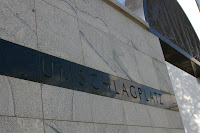 |
| Courtyard surrounded by apartments within the Warsaw ghetto. |
Today was a bit more on the "I went to Europe!" side of things, as the itinerary allowed us a bit of free time in Old Town Warsaw.
The morning consisted of another tour of Warsaw, which included visiting sites within the Warsaw Ghetto. I was surprised at how big the Ghetto area is; perhaps because of it's representation in films and what I had pictured in my mind based on personal testimonies and stories I have heard.
We also visited Mila 18, Umshlagplatz (the deportation area for the Warsaw Jews - to the camps), and several different monuments.
 |
| Eating zapikanka, the national street food of Poland. |
Umshlagplatz is the place Pinchas and his family were deported from. Near the area is now a large marble monument - something that bothers him, he says, as it has little meaning or representation.
Our Free Time was much needed, appreciated, and great fun. The Old Town part of the city is gorgeous with stereotypical European streetscapes. I took advantage of this time to separate myself from the group and wind down, relax, and enjoy.
I so needed this: time to browse cheap souvenir shops, eat overpriced but delicious food, and wander the streets at my own pace, taking in the scenery; the sights, the smells and the sounds. I did find myself a gorgeous amber and silver ring in a neat little jewelry store. I plan to post more on what I brought home from the trip - materialistically and intangible - at a later date.
 |
| The Righteous Among the Nations we met is seated in front row, wearing white. I'm on floor, front row, center. |
It was fantastic to have this opportunity and to hear her story - with fear, sadness, and good spirits and laughter - and it was so heartwarming to see how thrilled she was to be there, seeing herself in our eyes.
Due to lack of my own words, I leave you with this:
Key Points of Interest / Other Sites Visited Today:
The Umschlagplatz: "A square near Zamenhoff and Stavki streets, in the northern parts of the Warsaw Ghetto, near the freight train depot and the vocational school. After being gathered in the Umschlagplatz courtyard, most of the Warsaw Jews were sent to Treblinka, while a minority was sent to other camps. The station began to operate with the first 'actions' in the summer of 1942. Today the site is marked by a memorial wall inscribed in Polish, Yiddish, and Hebrew, commemorating the spot. The Polish authorities erected a new memorial on the former site of the gas station." (MRH Notebook 2011).
Mila 18: "The Z.O.B. (Jewish Fighting Organization) main Warsaw bunker during the April uprising. AFter the great Ghetto fires and losing its bases, this is where many troops assembled, using it as the organization's headquarters. On May 8th the Germans surrounded the bunker. As they no longer had any hope of survival, many warriors committed suicide. Several of them were poisoned by the gas bombs hurled into their hideaway. More than one hundred warriors died here, including Mordechai Anilewicz, commander of the Uprising. The 8th of May marked a turning point in the Ghetto battles. Until that day there were few Z.O.B. victims. After conquering the bunker, SS. General Stroop made a report to his superiors. To this day, the warriors' bodies remain beneath the rubble. Nothing is left of the bunker. A hill of testimony was erected in the spot after the Ghetto was freed." (MRH Notebook 2011).
Info on the Warsaw Ghetto Uprising: "Between 1941 and 1943, underground resistance movements were formed in approximately 100 ghettos in Nazi-occupied eastern Europe (about one-fourth of all ghettos), especially in Poland, Lithuania, Belorussia, and the Ukraine. Their main goals were to organize uprisings, break out of the ghettos, and join partisan units in the fight against the Germans.
...
The most famous attempt by Jews to resist the Germans in armed fighting occurred in the Warsaw ghetto, where the largest single revolt by Jews took place.
In the summer of 1942, about 300,000 Jews were deported from Warsaw to Treblinka. When reports of mass murder in the killing center leaked back to the Warsaw ghetto, a surviving group of mostly young people formed an organization called the Z.O.B.. The Z.O.B., led by Mordecai Anielewicz, issued a proclamation calling for the Jewish people to resist going to the railroad cars. In January 1943, Warsaw ghetto fighters fired upon German troops as they tried to round up another group for deportation. Fighters used a small supply of weapons that had been smuggled into the ghetto. After a few days, the troops retreated. This small victory inspired the ghetto fighters to prepare for future resistance.
On April 19, 1943, the Warsaw ghetto uprising began after German troops and police entered the ghetto to deport its surviving inhabitants. The heavily armed and well-trained Germans encountered fierce resistance from 750 fighters. The ghetto fighters were able to hold out for nearly a month, but on May 16, 1943, the revolt ended. The Germans had slowly crushed the resistance. Of the more than 56,000 Jews captured, about 7,000 were shot, and the remainder were deported to killing centers or concentration camps." (MRH Notebook 2011).
 |
| Certificate of the Righteous Among the Nations |
"He who saves a single life saves the world entire" - Talmudic dictum



No comments:
Post a Comment